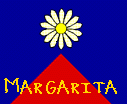Other Cuisines
Marga's Food

marga@lacabe.com
| The Aymara people constitute one of the two main indigenous groups of Bolivia, and are also present in southern Peru, northern Chile and north-western Argentina. Known for their unique clothing style, and in particular the colorful skirts and elegant bowler hats, the Aymara continue to fight assimilation. There are currently almost three million Aymaras throughout their region.
No one knows quite where they came from - or can really decide who qualifies as an Aymara - but the people trace their descent from the civilization behind Tiwanaku, an ancient city which collapsed at the end of the first millenia AD. By the 12th century, Aymara-speaking people were settled throughout the area surrounding Lake Titicaca and the Andean altiplano. In the 15th and 16th century they were conquered and subjugated by the Incas and later by the Spaniards, who forced them into near-slavery conditions and who brought diseases that disseminated much of the population. Racism, exploitation and forced acculturation has plagued them even after the countries were they are located achieved independence.
Aymara and Quechua cuisine are closely related, and at the heart of Peruvian and Bolivian cuisine. Some of their most famous dishes include kalapurka, a soup heated by the insertion of volcanic rocks, alpaca chaski - a dried, salted alpaca, from where the English word "jerky" comes, and, of course, dishes based on potatoes or quinoa.
For my quick sojourn into Aymara cuisine, this is the recipe I made:
Waja
Beef and Potato Stew

Waja, also known by its Quechua name Watia/Wativa/Huatia/Guatia, is a stew-like dish of meat or vegetables and potatoes consumed for centuries by the Aymara and Quechua speaking people. It's named after the dirt oven in which it is traditionally cooked, and its ingredients do vary by community. It's a close relative of pachamaca, which is also cooked in such ovens. While you are welcomed to try to build a huatia in your own backyard, and I have no doubt it could be a fun endeavor (there are plenty of videos showing you how), you can also make it on the stove using a regular cooking pot. Ingredients will vary by community - while llama and alpaca were used back in he day, beef, chicken, lamb and pork are more common now. The meat is commonly served with fresh or preserved potatoes as well as other vegetables such as squash, pumpkin and corn.
I followed a Chilean version of this recipe and was surprised at just how tasty it was. The orange juice gave it a bright note of acidity and light sweetness while the mint brightened it even more. I served it with boiled potatoes. It's definitely a recipe that deserves being made again and served to guests.
PRINT PDF
Waja
Ingredients
- 2 lbs beef chuck, cubed
- 1 1/2 tsp ground cumin
- 1 1/2 tsp red pepper flakes
- salt & pepper to taste
- 2 cups orange juice
- 1/2 cup cooking oil
- 1 onion, chopped
- 2 sprigs of mint
- 2 sprigs of cilantro
- 5 garlic cloves, minced
- 1 lb potatoes
Directions
Place beef cubes in a large bowl. Add the cumin, red pepper flakes, salt and pepper to taste and orange juice. Mix and marinate for one hour. Remove from the marinade, reserving the liquid, and squeeze out extra liquid from the meat.
Heat the oil in a cooking pot over medium-high heat. Add the beef and brown on all sides. Reduce heat to medium, add the onion, the mint and the cilantro and sauté until golden brown. Add the minced garlic and cook for a minute. Add the reserved marinade.
Cover the pot, turn heat to low and simmer until the beef is cooked through, about 1 1/2 hours.
Meanwhile, boil the potatoes in salted water. Serve stew with the potatoes.
|
Adapted from Carlos Uhart M.'s recipe at Comidas Chilenas
Related cuisines I've explored so far: Argentine, Bolivian, Chilean
Do you have a comment on this recipe? Please make it here
|